To fill a planter box, start with a weed barrier material. Add a layer of drainage material like rocks or gravel to prevent waterlogging. Add a good quality raised garden mix and compost into the box, leaving enough space for your plants. Gently pat down the soil and make sure it’s level. Finally, plant your flowers, herbs, or vegetables, add mulch, and water well.
This article will explore all you need to know about how to fill a planter box at home. Find out how to prepare your soil and how to line your planter box.
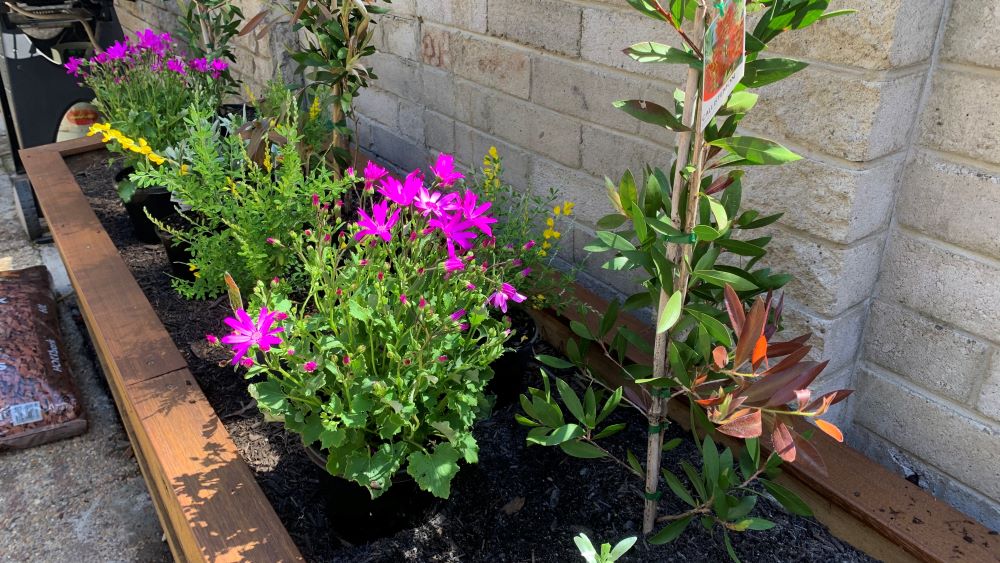
Simple Steps to Fill a Planter Box
Here are the simple steps to fill your planter box.
- Place weed matting on the bottom of the planter box if you have invasive weeds like couch grass.
- Layer bricks, large rocks or logs on the bottom of large planter boxes to fill the space cheaply and for drainage.
- Cover the rocks with a layer of river sand.
- Fill the planter box with good quality raised garden mix or all-purpose potting soil.
- Mix compost and aged cow manure through the top layer of the planter box.
- Plant vegetables, annual flowers or citrus in the planter box.
- Cover the soil with mulch and water it in.
The rest of this article will cover all you need to know about how to fill a planter box at home in more detail.
Materials Needed to Fill a Planter Box
When it comes to filling a planter box, the materials you use are just as important as the plants you choose. Here are the materials you will need to get started:
Soil Selection
Choosing the right soil is crucial for the health and growth of your plants. Look for a high-quality soil that is specifically designed for container gardening. It will be well draining but will not drop in level as much as regular potting soil over time.
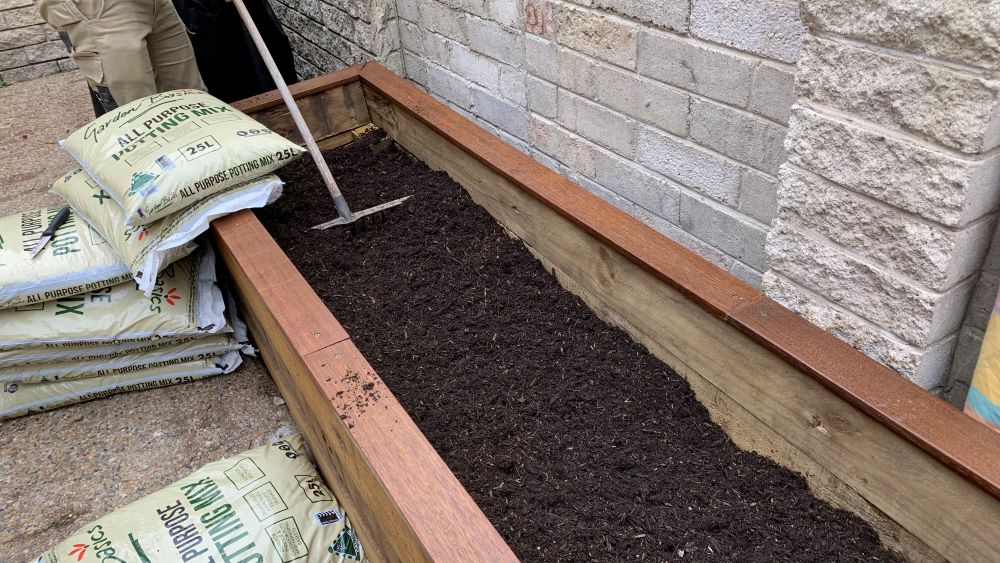
Avoid using garden soil, which can be too heavy and dense for planters. The potting mix should be well-draining and rich in organic matter. You can also mix in some perlite or vermiculite to improve drainage.
Plant Selection
The plants you choose will depend on your personal preferences and the growing conditions of your planter box. Consider the amount of sunlight and water your plants will need, as well as their mature size. Choose plants that have similar water and light requirements so they can thrive together. You can also mix and match plants with different textures and colors to create a visually appealing display.
Tools
You will need a few additional tools to fill your planter box. These may include:
- Trowel or hand shovel for scooping soil
- Gardening gloves to protect your hands
- Watering can or hose for watering your plants
- Fertilizer or plant food to provide nutrients for your plants
Step by Step Guide to Fill a Planter Box
Filling a planter box can be a fun and rewarding gardening activity. Here is a step-by-step guide to help you fill your planter box and get your plants growing.
1. Prepare the Box
Before you start filling your planter box, make sure it is clean and free of debris. If your box does not have drainage holes, drill some holes in the bottom to allow excess water to drain out. If you are using a wooden box, consider sealing it with a waterproof sealant to help protect it from water damage.
Place your raised planter box straight onto garden soil or landscaping rock to allow the water to drain out of the bottom. To find out more about the best depth for planter boxes for vegetables, check out my previous article.
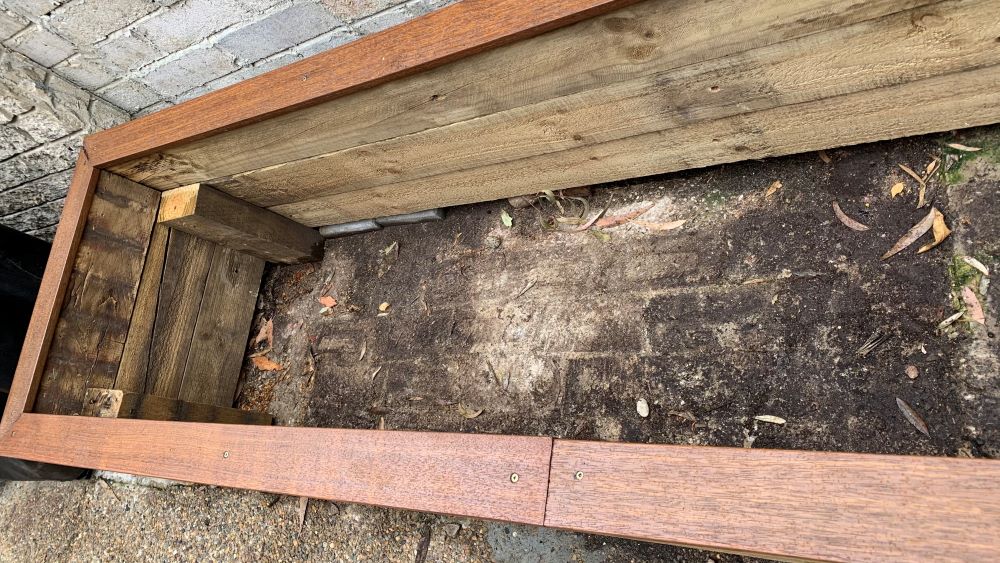
2. Line Your Planter Box with Garden Fabric
Line your planter box with garden fabric or weed matting. This will drain well but keep the soil from being in contact with the walls of your planter box and will stop weeds from growing through the bottom off the bed. Hold the garden fabric in place with a staple gun before filling with coarse sand and soil.
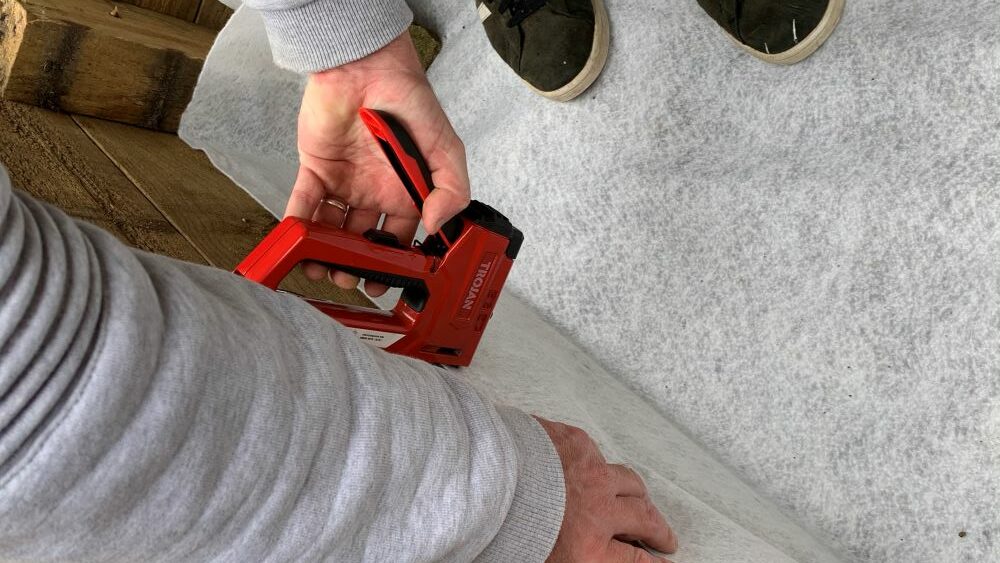
3. Add Fill and Drainage Material
Large rocks or bricks can be used to fill the bottom of your planter box to take up space but always cover them with some river sand. Putting small pebbles or rocks in the bottom of the planter box can create an area for water collect rather than drain away.
It is better to use a coarse sand on the bottom later of a planter box rather than small rocks. If this does get mixed through with your soil it will add structure and stop the soil level from dropping as quickly.

2. Layer the Soil
To ensure proper drainage, it is important to layer the soil in your planter box. Start by adding a layer of gravel or rocks to the bottom of the box. This will help to prevent water from pooling at the bottom of the box. Then add a layer of potting soil, making sure to leave enough space for your plants. Here is how to layer soil in your planter box.
River sand
If you have a deep planter box, start with a layer of river sand. If you have a large planter box this will save you money as it is more affordable than planter box soil mix. Make sure there is at least 12-18 inches of topsoil for growing vegetables. River sand has larger pieces that regular fine sand used in sandpits so will be great for drainage.
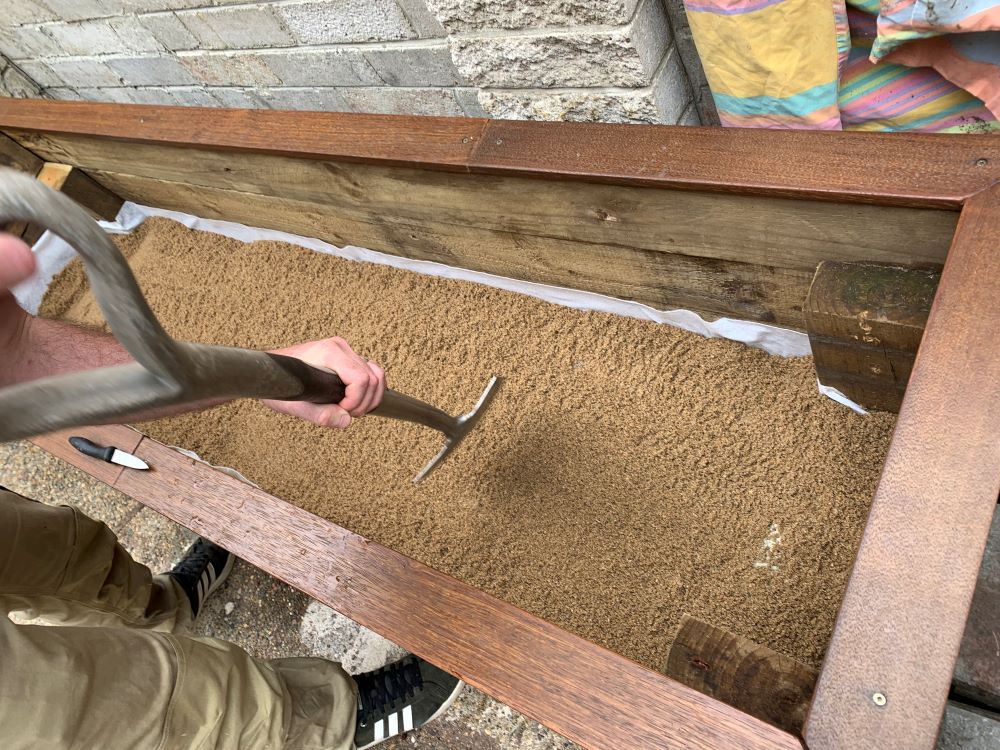
Good Quality Raised Garden Soil Mix
Use good quality raised garden mix as the main ingredient to fill your planter box. Layer this on top of the river sand but do not mix it with the sand. Raised garden mix will contain a mix of organic matter and sand which is perfect for raised garden beds. It will resist compaction and improve drainage for your plants.
This will be available from your local garden center, hardware store or from landscaping suppliers.
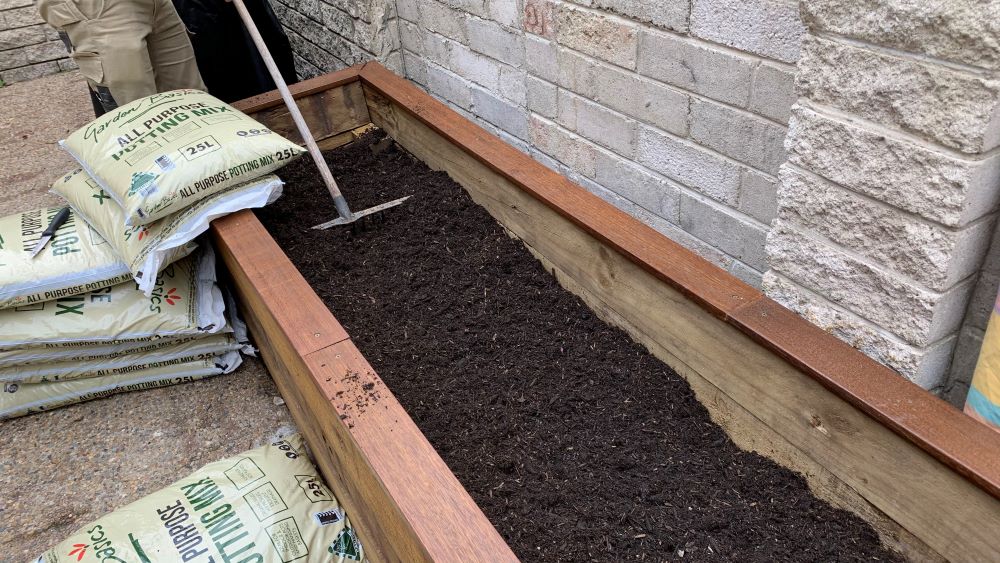
Compost
Adding extra compost to your planter box will add organic matter and soil microbes. If you have home made compost this will be the best as it will contain a range of materials from your own home and will be completely organic. You can also add worm castings from your worm farm.
Mix the compost through the top layer of your planter box so that the plant roots can reach it. You can add more compost to the top of the container over time as a top dressing or when you replace vegetables after the growing season.
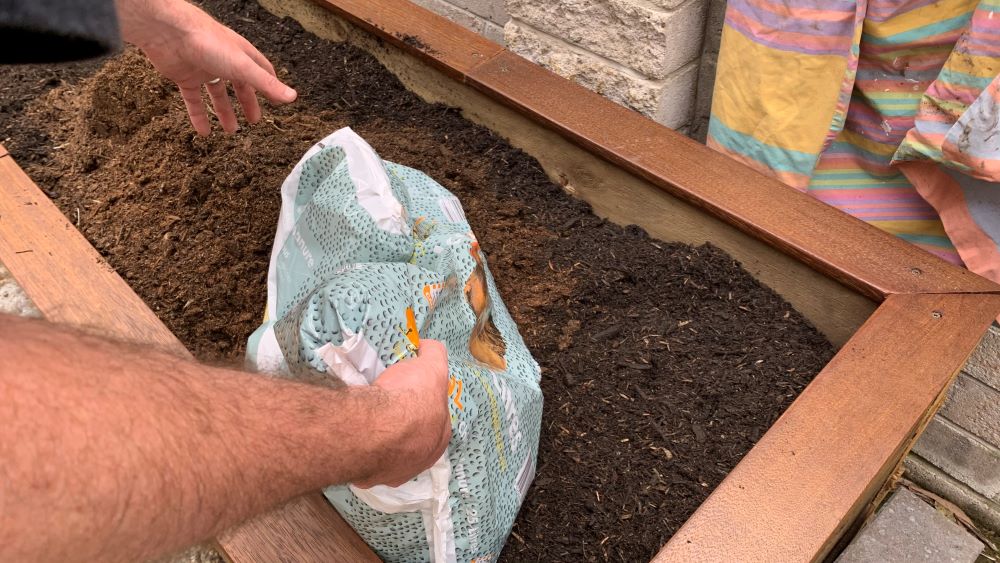
You can also use home made worm castings in planter boxes. Simply sprinkle a thin layer on the top of the soil around the root zones of plants and water it in.
Aged Cow or Chicken Manure
Aged cow or chicken manure is the perfect ingredient to add to your planter box. It is a mild fertilizer and will add organic matter. This will help to fill out your container and your plants will love it. Add around 1 shovel full per square foot and dig it through.
Use aged cow manure to add extra organic matter and nutrients to raised garden beds. After adding well aged cow or chicken manure you can plant straight into the soil.
3. Planting
Choose plants that are suitable for the size of your box and the amount of sunlight it receives. Arrange your plants in the box, leaving enough space between them for growth. Make sure to follow the planting instructions for each type of plant, including how deep to plant them and how much water they need.
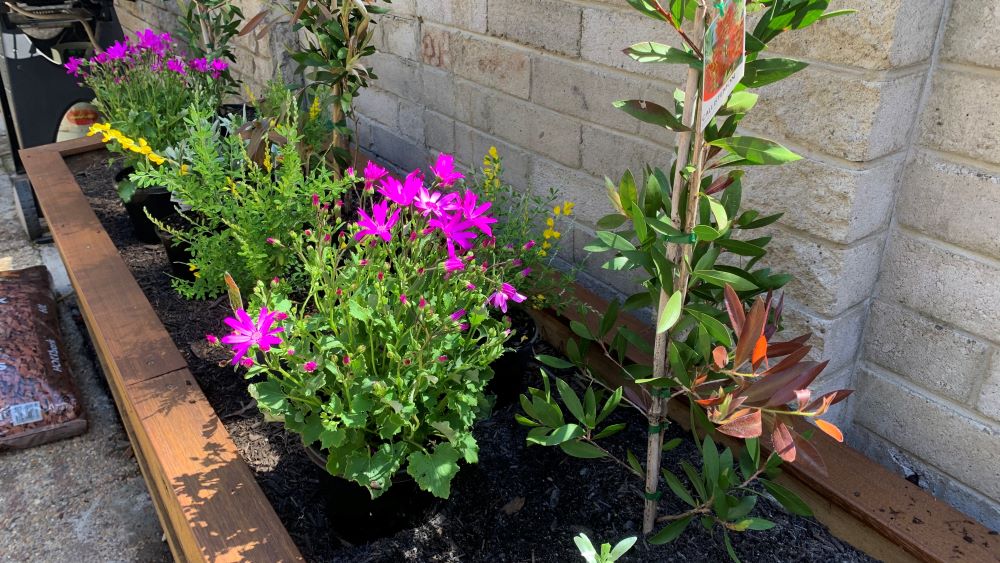
4. Mulch
After planting, add 2-3 inches of mulch. I like to use wood chips but you could also use straw, sugar cane mulch or pebbles.

5. Watering and Maintenance
After adding mulch, water your plants in well. Make sure you also water your plants regularly from then on. Container plants will dry out faster than those growing in the ground. Check the soil regularly to see if it is dry, and water your plants if necessary.
Fertilize your plants after 2-3 months (if the soil already contained slow release fertilizer). Prune your plants regularly to promote healthy growth and prevent overcrowding.
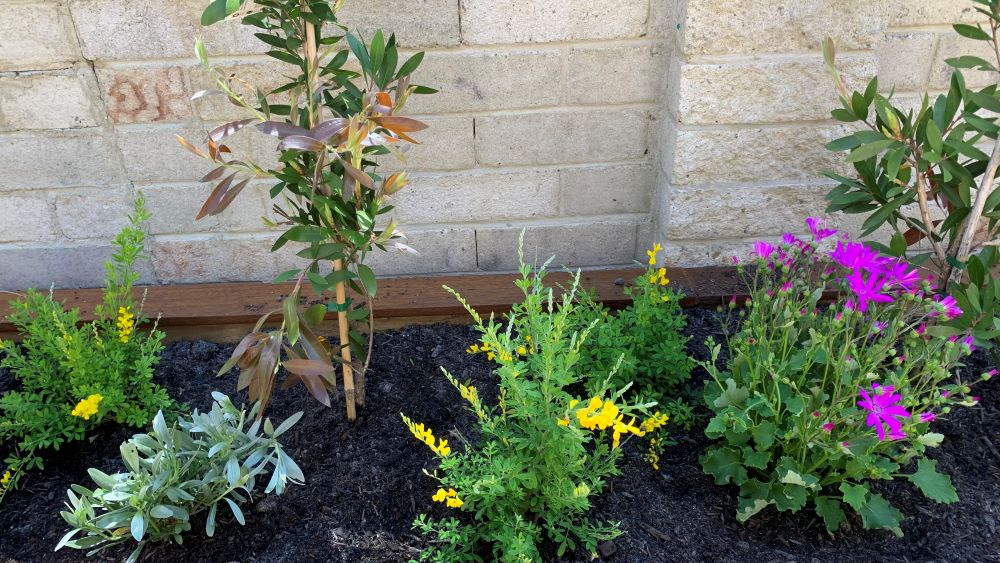
What to Put in the Bottom of a Planter Box
If you have a deeper planter box, you can use river sand as a base to fill the bottom layer. River sand will drain well and will save you money if you have a large planter box to fill. Make sure that your plants still have a good depth of good quality soil to grow in.
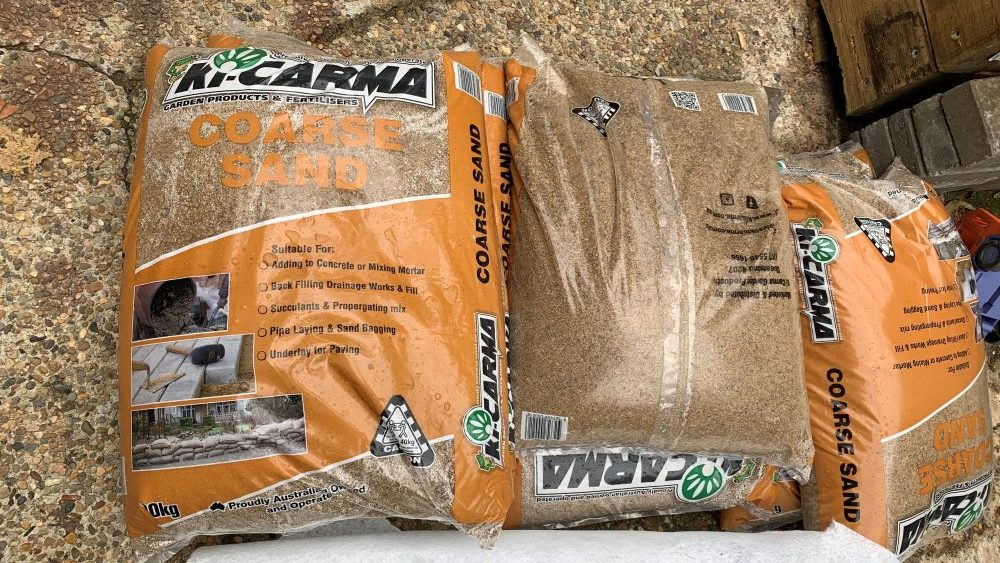
If you have a smaller planter box then fill the whole depth with soil specially made for raised garden beds. Having at least 2-3 feet of good quality soil mix will give vegetables the depth of soil that they need to grow well.
This is also important if you are planting a deep rooted plants like small trees. Ideally trees like citrus will need at least 3 feet of soil depth to thrive overtime.
How to Fill Large Planter Boxes
To fill large, deep planter boxes you can fill the bottom with organic materials including logs, sticks and plant matter. This will work well if the planter is away from your house as there is risk of termites. This process is based on a growing method similar to Hugelkultur beds.
For Hugelkultur beds, logs are buried in the ground and covered with organic matter and garden soil. The logs will break down over time improving the soil. These logs can take 10 or more years to break down completely.
You can also use river sand, bricks or a cheaper potting soil mix and improve it with organic matter, river sand and worm castings. Landscaping suppliers can deliver larger amounts which will be a much cheaper way to fill your container.

Replacing Soil in Planter Boxes
You will not need to replace soil in your planter box, instead top it up with compost, more raised soil mix and aged cow manure. Over time the soil level will drop as it compacts with gravity and as the organic matter breaks down.
If you are clearing the garden seasonally, like for vegetables, you can mix through more organic matter with a fork to lighten the soil and give your plants more nutrients. If you aren’t replacing the plants, you can add compost around the root zone on top of the soil without disturbing the roots.
Summary
Filling a planter box successfully comes down to finding the right mix of soil that has a good mix of organic matter and soil components like sand. Planter boxes are the perfect place to grow vegetables if you set them up right.
Remember to choose a planter box that suits your needs and style, and make sure it has proper drainage holes. Use a filler material at the bottom of the planter to reduce the amount of soil needed. Choose a high-quality soil mixture that provides the right nutrients for your plants, and consider adding compost or aged manure for extra nourishment.
When planting, be sure to space your plants appropriately and water them regularly. Use mulch to help retain moisture and prevent weeds. And don’t forget to fertilize your plants according to their needs.
Frequently Asked Questions
What are some inexpensive options for building planter boxes?
If you’re on a budget, you can use inexpensive materials like reclaimed wood pallets, cinder blocks, or even old tires. These materials can be sourced for free or at a low cost, and can be repurposed into unique and functional planter boxes. My wooden planter box looks great with flowers and small shrubs.
What are some creative materials to use for filling the bottom of a planter?
To save money and reduce the weight of your planter, you can use a variety of materials to fill the bottom. Some options include rocks, broken pottery, packing peanuts, or old tree branches. Just make sure to cover the filler with coarse river sand which will fill the gaps.
How can I ensure proper drainage in a planter box?
Proper drainage is essential for healthy plants in a planter box. To ensure good drainage, make sure your planter has drainage holes and fill the bottom with a layer of gravel or other coarse material like river sand.
What are some decorative fillers for planter boxes?
To add some visual interest to your planter box, you can use decorative fillers like colored glass beads, seashells, pebbles or even marbles. These fillers can be placed on top of the soil or mixed into the soil mixture for a unique look.
What are some popular plants to use in planter boxes?
Many plants thrive in planter boxes, including herbs, vegetables, and flowers. Some popular options include tomatoes, basil, petunias, and marigolds. When choosing plants for your planter, make sure to consider the amount of sunlight and water they need.
What are some tips for maintaining healthy plants in a planter box?
To keep your plants healthy, make sure to water them regularly and fertilize them as needed. You can also prune them to promote healthy growth and prevent overcrowding. Additionally, make sure to monitor your plants for pests and diseases and take action if necessary.
I am an accredited practicing dietitian, experienced gardener and a dedicated cook. I love writing and sharing my experience so you can learn from my successes and mistakes.

Comments are closed.